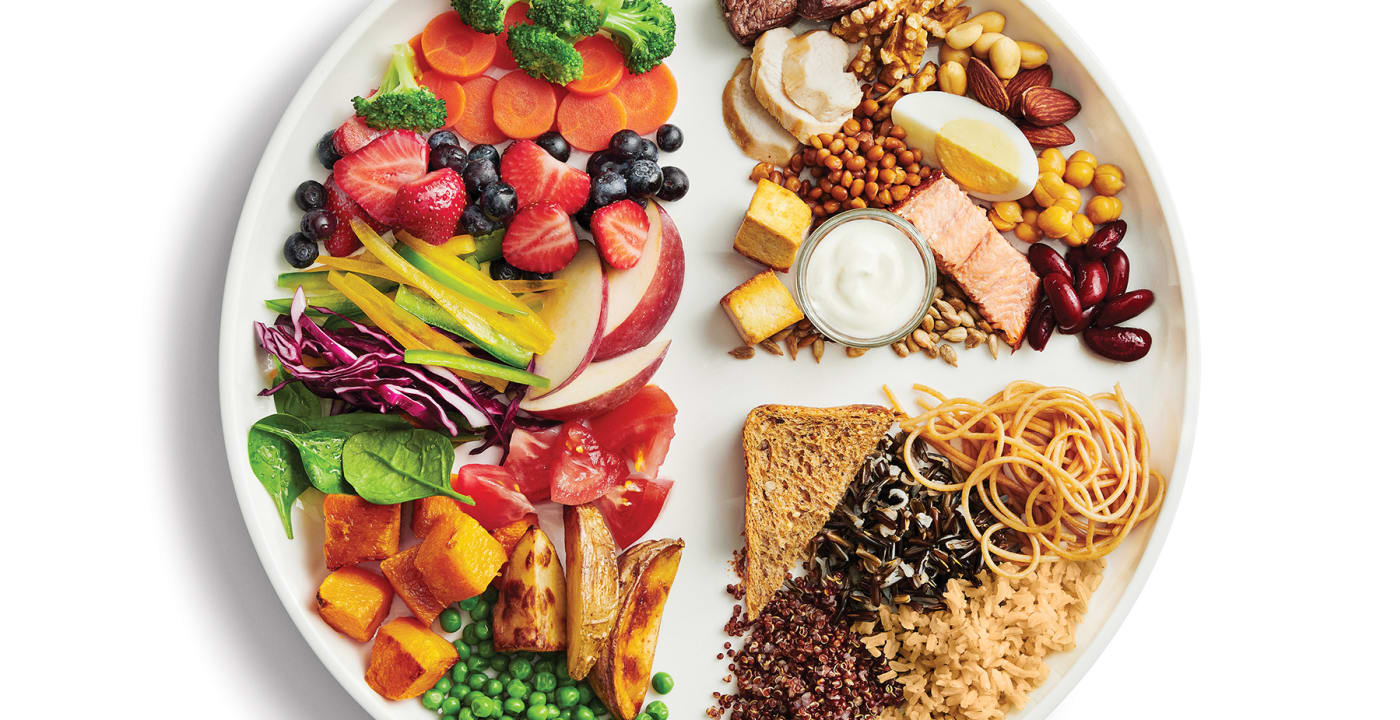What we can learn from Canada’s new food guidelines

By Erica Lewis, MS, RD, CD
Drink more water, eat more plants and cook more at home, says Canada.
Canada’s new food guidelines have transformed from a food pyramid to an “eat well, live well” infographic, which takes a slightly different spin on our current USDA MyPlate recommendations.
Specific foods and serving sizes are no longer emphasized in the new guidelines. Instead, the goal is to continuously make healthy food decisions and lifestyle choices, such as being active and finding ways to reduce stress.
It is also how we eat that makes a difference. While we eat, we should be mindful and enjoy spending time with others. Eating is a time to be social and celebrate with friends and family.
What Canada recommends consuming less of
Extra emphasis is placed on limiting processed and prepackaged food items high in sugar, salt and saturated fat.
The new guidelines also consider health risks associated with higher alcohol intake. If we do consume alcohol, the guidelines recommend we drink alcoholic beverages in smaller amounts and less frequently.
Fruits and vegetables
Instead of fruits and vegetables being two separate food groups, they are now considered one and should take up half of our plate; high intakes are encouraged.
The Canadian plate has taken it one step further and no longer considers fruit and vegetable juices a serving. Instead, fresh, frozen and canned fruits and vegetables should be consumed to reach your allotted goal of at least five servings daily.
Variety and color is key when it comes to eating produce. Expand your palate by taste-testing new and uncommon items such as persimmon, dragon fruit, pumelo, Brussels sprouts or spaghetti squash.
Whole grains
This group is not any different than our current MyPlate standards in the United States. Canada’s new infographic just reminds us of all the whole grain options out there.
Experiment with different whole grains such as corn tortillas, wild rice, steel cut oatmeal, couscous or whole wheat pita bread.
If you are more accustomed to eating white (or refined) products, consider taking small steps forward by mixing white and brown rice or different pastas together.
If your favorite cereal is low in fiber, mix it with another cereal with at least six grams of fiber per serving.
Protein has expanded
Dairy foods, which include cheese, yogurt and milk, are now considered part of the protein group and are no longer in their own category. Moreover, emerging research is showing higher-fat dairy products are not harmful to our health, but may actually provide health benefits, so the type of dairy products we consume is not as much of a concern anymore.
The new Canadian guidelines bring an emphasis on embracing many healthy options. However, it is not as simple as swapping in one protein source for another. Each protein food is packed with a different set of nutrients. While eating animal-based protein provides all essential proteins in one punch, heart-healthy and plant-based proteins should also be consumed in high amounts. Again, this is where variety comes into play.
Reduce your carbon footprint and increase your health by eating beans such as navy, pinto, black, lima and cannellini, or peas. Add whole soy foods to the mix: edamame, tofu and tempeh, and any variety of nuts and seeds, such as almonds, walnuts, pepitas or sunflower seeds. Oh, and don’t forget about those delicious nut butters.
Add some flavorful spice combinations and the options are endless:
Looking for a quick and easy way to get more nutritious foods in and eat more plant-based, high-fiber and nutrient-dense meals? Roast three or four nights’ worth of vegetables and chickpeas with garlic, chili powder, coriander, onion and cumin for a taste of Mexican cuisine.
Feeling something different? Turn it into a Thai dish by mixing together basil, cumin, ginger, turmeric, curry powder and garlic.
Want a more Mediterranean vibe? Add oregano, rosemary, bay leaves and basil with cloves, ginger and cardamom to your meals.
Add oregano and you’re coming close to French, Middle Eastern or Cajun flavors.
Experiment with spices and make up your own recipes. Spices add antioxidants, nutrients and variety. Cooking is both an art and science — have fun with it.
Where the glass of milk was, water has taken over
Water is a necessity for life, and yet always seems to come in last when we talk about our favorite drinks. Water should be consumed the most, as emphasized in the Canadian food guidelines graphic.
This beverage not only hydrates our bodies, including our skin, but also provides no calories and is free. If you are bored with plain water, add different fruit, vegetables, spices and herb combinations or try sparkling water and unsweetened tea.
The USDA announced in December 2018 that our MyPlate recommendations will be revised again soon. It will be interesting to see how they align with the Canadian food guidelines.
Learn more about the updated Canadian food guidelines



